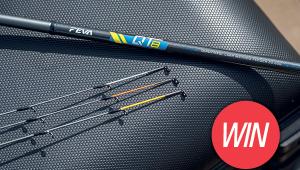I Like It Wild!
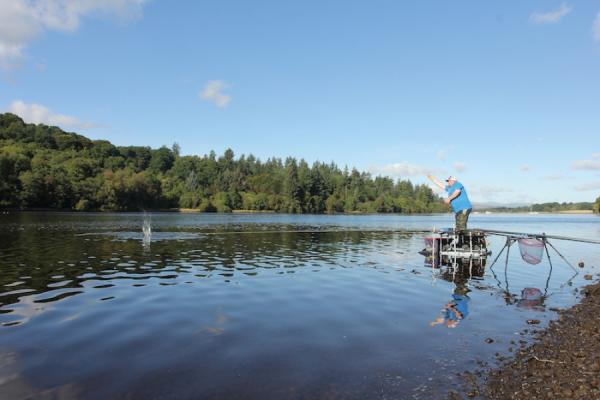
Tackling Big Natural Venues
Match Fishing takes a road trip to bonnie Scotland, where Scottish international James Woodrow uncovers his tactics and tricks for tackling the daunting but beautiful Loch Ken…
You join me today on the banks of Loch Ken, a water we regularly fish matches on here in Scotland. Some anglers are scared of this venue, while others, myself included, thrive on the buzz of fishing it.
At over nine miles long it’s a colossal venue, and until very recently, legering has been the dominant way to catch fish on this vast expanse of water. In the last few years, the huge shoals of roach seem to have ventured much closer to the bank, well within reach of the waggler, pole, and even whip!
Of course, there are numerous daunting match venues like Loch Ken all over the UK, and getting the tactics right to draw fish into close range and then catch them, can be difficult. Today, I’m hoping to give away some tricks that you can use to make the most of these fantastic waters!
Draw The Fish In…
The first thing to consider on big venues is how you’re going to attract the fish in close enough to catch them. These fish will only venture close to the bank for one reason, and that is to feed.
There’s little scope for messing around with small amounts of bait for this game. The shoals of roach and hybrids here flock into the shallows to feed, and will settle in the swims that have enough bait for them to settle and graze.
To start the session, I like to create a bed of groundbait by balling in nine large balls of groundbait. I squeeze five of the balls very lightly so that they break up quickly and create a carpet area on the bottom for fish to settle on. The other four are squeezed much firmer, meaning they break up after a little more time, creating prolonged activity and a steady release of the feed within the balls.
Noise Matters!
I’m convinced that the noise of the balls hitting the water almost certainly attracts fish on large venues. I’ve fished several matches here where the anglers either side have cupped in their bait, or started by loose feeding, and every time I’ve got off to a very strong start.
For this reason, I try my best to make sure I’m the first to ball in my bait at the start. Noise also has a big influence on how I re-feed or top up the swim during the session. I’ve had a lot more success when I loose feed casters compared to maggots on big venues like this.
Firstly, casters make a lot more noise when they hit the water, which is sure to attract fish. Secondly, casters can be fired in a lot more accurately than maggots, especially if there’s some wind on the venue, as there often is on these places. Another good little trick is to use your maggots as a secondary boost if you need it. You may catch well for two or three hours feeding casters, before things go very quiet. Changing to feeding maggots at this point can sometimes instigate fish to feed again.
Ball It Short
I have started today’s session by balling in my groundbait, making a conscious effort to throw it in just short of the pole tip. Fishing on the outer edge of your baited area is deadly on big venues like this. The fish naturally home in on the feed area from out in the middle of the loch, so the first bait they come to is the outer edge.
In my experience, the fish you catch here are always a bigger stamp. The smaller, ravenous fish get right in on the main baited area, while the bigger ones sit just back from it, picking off loose feed falling past the groundbait and small fish. Balling the main bait a foot short of the pole time helps me fish on the outer edge.
The wind also has a nasty habit of turning around and blowing towards you on big venues like this. This can cause your rig to blow in away from your feed, especially if you ball in your feed right on the pole tip, meaning you won’t be fishing over your main feed area.
Immediate Feeding
Straight after balling in my groundbait at 13 metres, I ship out and lay my rig in. As it’s settling, I fire a good two-thirds of a pouch of casters over the top. Like the groundbait, I always aim a little shorter, so the overspray and back end of the loose feed extends just past the pole tip.
This overspray is really important. It’s this bit of bait landing beyond where I’m fishing that brings in the fish from out in the main loch. These caster making noise and falling through the water over a wide area get the fish competing, darting around the swim, and draw in new fish.
Despite throwing in all that bait at the start, I can’t stress enough the importance of feeding like this from the outset. With so much water to pull fish from, and so many feeding fish flocking in to feed, the only way to keep them in your peg is to feed regularly.
Focusing Feed
First drop in today with a single dead red maggot I’ve caught a roach around 3oz; proof the initial feeding has been effective. Missed bites have been a little annoying at the start of the session, but this can be expected.
All the activity in the area, with the groundbait fizzing up, can cause the fish to be a little scatty, and dash about all over the swim. It can sometimes be a case of having a little patience and waiting for the fish to settle during the first 20 minutes of a session. Quite a few dace have hit the net early in the session, but I’m now settled into a good run of roach.
The million-dollar question, of course, is what to do when the action slows? The first thing to do is make sure you notice it. Keep tabs on how often you’re shipping back with a fish on, and as soon as you feel it’s slowing, you need to make a move.
If you’ve been loose feeding regularly enough, you should never stop getting bites. You may notice that your stamp of fish goes smaller; you begin to miss more bites, or the wait between bites gets longer. This is probably because the fish have spread out a lot more, possibly because a predator has moved into the swim, or due to you catching too many of their mates.
When this happens, I like to re-focus them by feeding some more groundbait. I simply have a top-up mix that is rich with casters and hemp, and try feeding small hard balls, that I make with one hand, as accurately as possible. I’m confident to do this by hand, and try and throw the balls just short of the pole tip.
If you’re not happy throwing in the balls, simply pot an odd ball in every five minutes or so. This helps to create a small hotspot of feed on the bottom where the fish should re-focus. Again, don’t stop loose feeding at this point. This is vital to keep drawing in fish.
Rig Choice

Despite my attack being very positive, I like to use fairly light rigs on this venue when the conditions allow. The reason for this is because the water is clear, and I’m loose feeding a lot of bait. After much experimentation, I’ve found that you miss fewer bites and catch slightly bigger fish by presenting a hook bait that steadily falls into the swim.
Another good thing about lighter rigs is that you can ship out, lay the rig in, and have time to loose feed before the rig has settled. The last thing you want to be doing is striking at bites halfway through loose feeding, often meaning you miss the bite while your loose feed goes everywhere!
The swim today is only five feet deep, and I’ve set up a 0.4g Sensas Series 18 as my heavier float, while a 4x12 Preston Chianti is used as my lighter one. Elastic is very important. You need something that is soft so fish don’t splash on the surface when you strike, but also allows you to swing in chunky 4oz fish to quickly get them out of the way of pike!
Top Tip!
I only ever use a dead maggot on the hook, for several reasons. Firstly, a dead maggot is much softer than a live one, and when fish suck it in they tend to hang on to it for much longer than they do a live one. Secondly, a dead maggot falls a little bit slower than a live one, and it may just give fish a split second longer to see and take the bait as it falls into the swim.
Finally, there is much less chance of a dead maggot doubling back over the point of the hook, causing bumped and lost fish.
Cast A Whip...
1. Hold the hooklenght in one hand and the whip in the other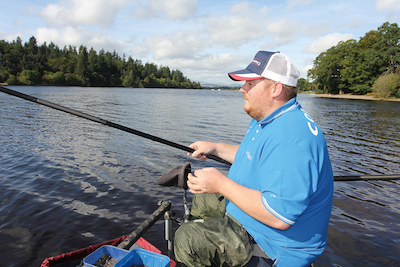
2. Bring the whip behind you while still holding the hooklength...
3. Then push the top hand and pull with the other to 'cast' the rig out!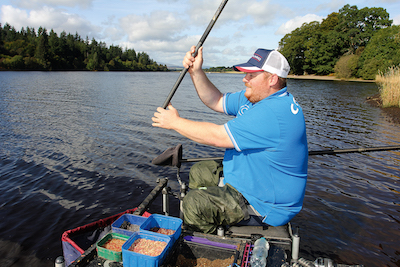
Upping The Ante
The fishing has got better and better as the session has progressed today, and interestingly the fish are coming right in on the feed! The heaver 0.4g rig has been best, and I’ve also found that a caster has been quite an effective hook bait for selecting a bigger roach or two.
With the fishing being so good, I’ve ended the session by catching on a whip! This doesn’t often work here, but on good days when the wind is favourable you can have some golden spells fishing the whip, that can really boost your weight. I’m using a 7m whip today, with a 7m long rig. This means that when my float is set at five feet deep I’m fishing just short of 13 metres, right on top of the feed I’ve been introducing on the pole.
A great way of deciding whether the pole or whip is better is to time yourself and count how many fish you catch in a 10-minute spell on the whip, compared to how many you catch on a 10-minute stint on the pole.
Today, the whip has given me a brilliant weight boost at the end, and I’ve finished the session with close to 200 wild Loch Ken silvers, in a bag pushing 20lb! With the right combination of positivity and finesse, you can make the most of big natural waters like this!
Enter The Silverfest!
The last two years have even seen an event created to celebrate this, in the way of the Van Den Eynde and Daiwa-sponsored Silverfest! This is a two-day float-only festival that has proved very popular already in its first two years. It normally takes place at some point in the final two weeks of September… keep your eyes peeled in the Coming-Up pages of Match Fishing magazine and its Facebook page for details nearer the time.
What's On The Ken Menu?
1. Dead maggots are best for the hook!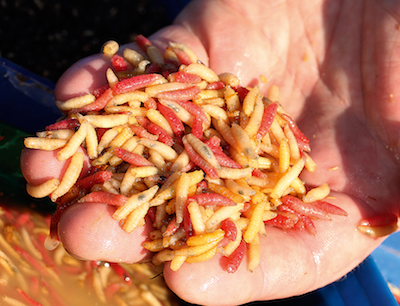
2. Hemp features heavily in James' top-up mix...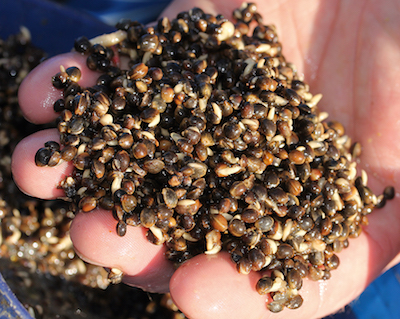
3. As do casters, which are also loose fed over the groundbait.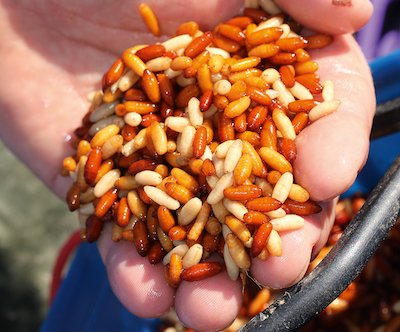
4. Ball this lot in at the start to create a caroet of feed for the fish to graze over.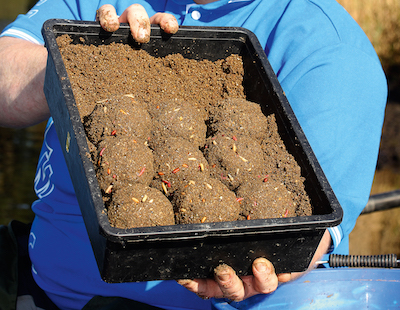
5. Maggots make a great change feed bait if it goes quiet on the caster.
Angler File
James Woodrow
Age: 30
Lives: Glasgow
Sponsor: Colmic
Venue File
Loch Ken
Location: Glenlaggan shoreline, near Castle Douglas DG7 3NF
Day tickets: On the bank
- Log in or register to post comments










